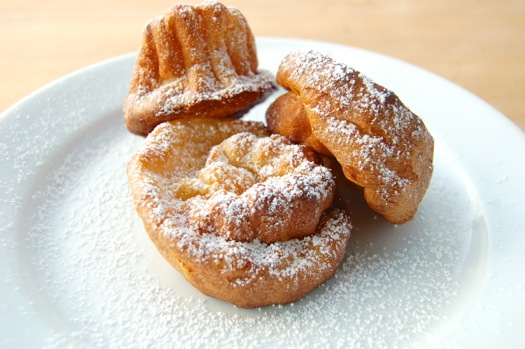Cannelés Attempt 2
So here I’ve baked up my cannelé batter, treating it more like a sweet popover. Lots of agitation, baking right away on high heat. Here’s what I got when my 35 minutes are up. Hey this is looking promising…maybe go a little lighter on the batter next time, fortify it with some more sugar and…

…oh…

Well it was worth a try. Here I’ve obviously got a more bread-like interior which is the (sort of) opposite of the custard interior I had the first time. That’s good since a moist custard-like interior is not what I’m going for. But a little bubble of sweet popover clearly isn’t going to cut it, no pun intended.

Hehe…well let’s see how the rested batter bakes up this afternoon. My hopes aren’t terribly high given what’s happened here, but who knows? These tasted great on a plate with powdered sugar I might ad. The girls hated yesterday’s dense ones, but they loved these!

Hehe…on to the next attempt!
Here’s the recipe and technique I’ve been using with great success. Hope you can read french. His technique is rather different than yours. 1) he says it’s very important that the milk be very hot when you pour it onto the egg-sugar mixture to lightly pre-cook the eggs. he boils the vanilla-infused milk, then lets it sit for 2 minutes before adding it in 5 additions, like tempering eggs in creme anglaise. he says that that is the essential trick for getting the right internal consistency. 2) he leaves the batter on the counter at room temperature for 24 hours, stirring from time to time. just before baking he beats it vigorously a couple of minutes to reincorporate the butter. 3) he fills the molds almost to the top. and 4) he bakes them for 15 min at 530 degrees to “fix” the pastry in the mold, so it doesn’t continue to rise, then at 400 degrees for 35 minutes to cook the interior.
As for molds, he loves copper for the best result, but the less expensive aluminum ones are quite alright. He vehemently advises against the silicone because it can’t stand the very high heat. And he uses a professional non-stick spray on the interior.
I’ve used his recipe with aluminum molds I picked up in Paris and have had no disasters.
http://www.lacuisinedebernard.com/2010/01/voila-mes-declicieux-caneles-ils-vont.html
Thanks very much, Candide! I shall try this!
Your friend,
– Joe
and don’t forget to follow his advice on letting them rest two hours after they come out of the oven. the interiors are rather compact after cooking. the rest allows them to aerate. it’s sort of like letting baguettes or croissants rest before eating them.
Hi!
Oftentimes, when it puffs up like this, it’s
1/ The batter has not rested for long enough (24 hrs is a must)
2/ The oven is not hot enough to cease and caramelize the outside
3/ The batter is “too heavy”. It is closer to a “Chou” dough than a crepe batter and can have to do with the ratio of liquid to flour and sugar.
Good luck, Cannelés are tough.
S.
Hey Stephane!
I was pretty sure I’d get a dramatic puff with this, but you know, it was fun to see what would happen. I appreciate the input of a seasoned cannelé maker this week. We’ll see where my little series of experiments leads!
Cheers,
– Joe